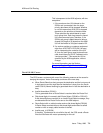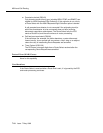
ASAI and Call Routing
Issue 7 May 1998
7-9
Denial (NAK) Causes
The ECS issues a route end with one of the following reasons as the cause for
denying the request. Vector Processing continues at the next step.
■ When Route Select has hunt group as the destination and the hunt group is
in night service and the night service destination is busy, then the cause
value CS0/16 (Normal clearing) is generated when in fact the destination is
busy.
■ Invalid Association (CS0/81)
This is generated when a Route Select is received after the Route End.
■ Dial-ahead digits in incorrectly built Route Select (CS0/96 or CS0/100)
If dial-ahead digits are received in an invalid Route Select message, they
are discarded and a Route End is sent to the ASAI adjunct.
■ Route Select with no called number and no dial-ahead digits (CS0/96)
A Route Select received without dial-ahead digits and without a called
number or with an empty called number is denied.
■ Invalid party_id (CS0/28)
If the party_id parameter is not valid for the call, the ECS sends a Route
End and continues with vector processing for the call.
This is transparent to the ASAI adjuncts, with two
exceptions:
1. If the maximum size UUI allowed on the
ISDN trunk is exceeded, then the lower
priority data items will be dropped. Whether
or not this means that ASAI UUI is dropped
depends on the priorities of the data items.
These priorities are administered on each
trunk group form. Each item stored in shared
UUI uses two extra bytes.Therefore, if the
ISDN trunk group is administered to allow a
shared UUI length of 32 bytes then the ASAI
UUI will be limited to 30 bytes instead of 32.
2. If a service provider, or customer equipment
other than a DEFINITY ECS (R6.3 or later)
will be interpreting the contents of the UUI
IE, then the trunk group used to place those
calls should have its UUI IE Treatment set to
“service-provider”. This sends the UUI as
specified by the ASAI application, without
change.
For more information, see the Section,
‘‘Integrated Services Digital Network (ISDN),’’ in
Chapter 12, ‘‘ASAI and Feature Interactions.’’


















